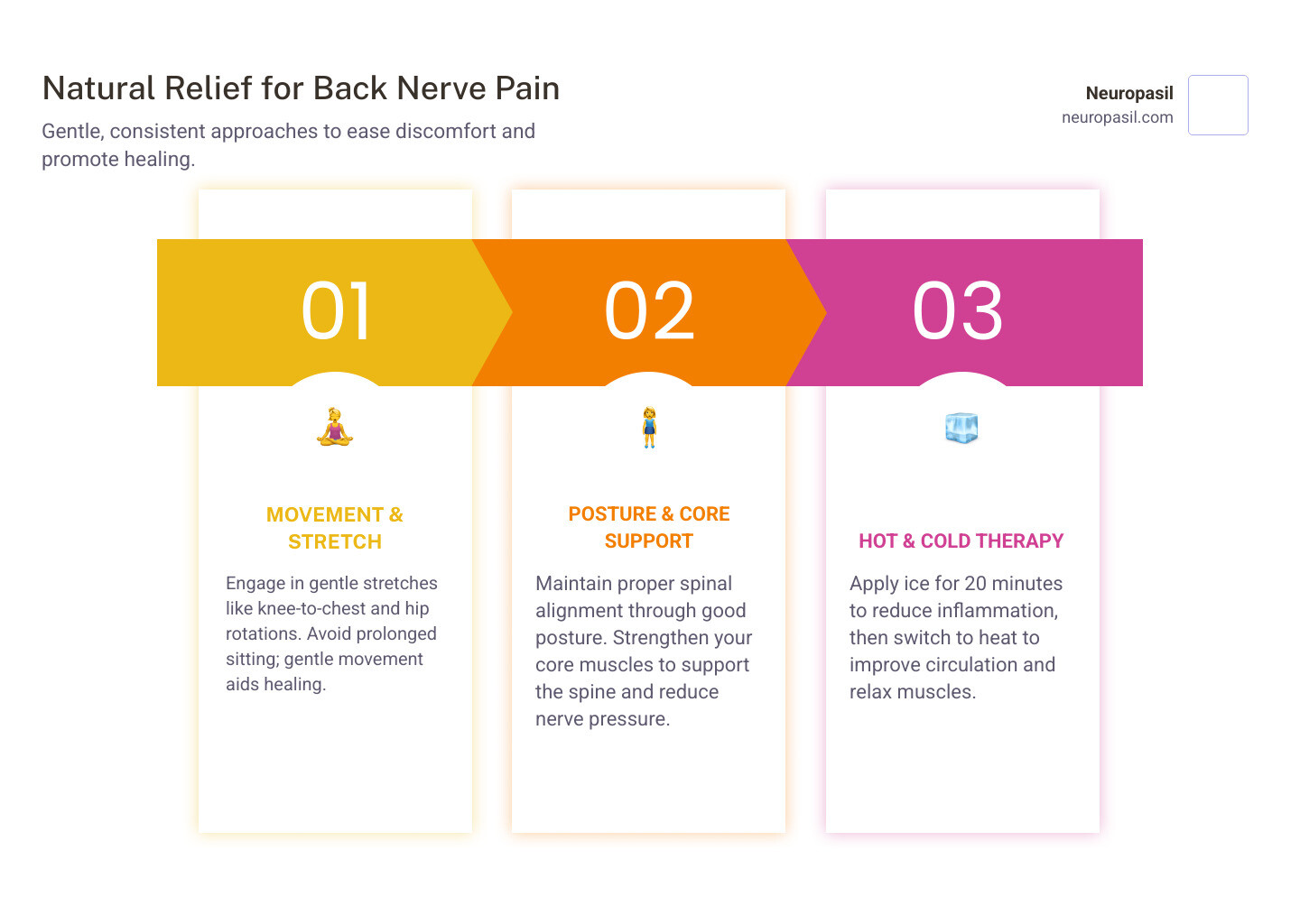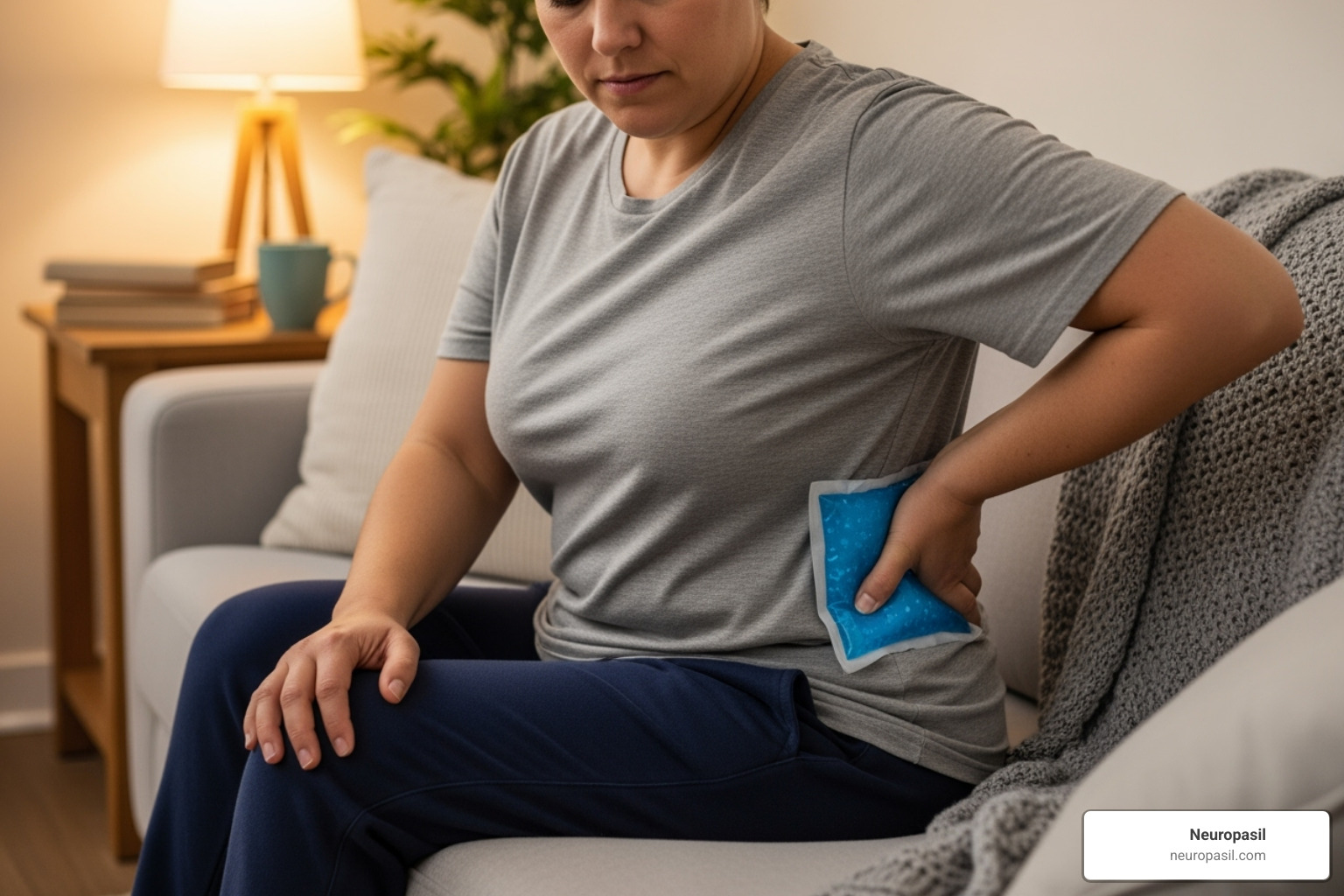Why Natural Relief for Back Nerve Pain Matters
Relieve back nerve pain naturally and you'll join the millions of people who've finded that gentle, consistent approaches often work better than harsh interventions. About 40% of people in the U.S. experience some form of sciatica during their lifetime, making it one of the most common types of nerve pain.
Here are the most effective ways to relieve back nerve pain naturally:
- Gentle stretching - Focus on hip external rotation and knee-to-chest movements
- Hot and cold therapy - Apply ice for 20 minutes to reduce inflammation, then heat to improve circulation
- Stay active - Avoid prolonged bed rest; gentle movement promotes healing
- Proper posture - Maintain spinal alignment to reduce nerve pressure
- Core strengthening - Support your spine with targeted exercises
Back nerve pain, especially sciatica, happens when the sciatic nerve gets irritated or compressed. This nerve runs from your lower back down to your feet, so when it's bothered, you feel it. The pain can be sharp, burning, or feel like an electric shock.
The good news? Most people (80-90%) with sciatica get better without surgery. Natural remedies work because they address the root causes - muscle tension, inflammation, and poor movement patterns - rather than just masking symptoms.
Your body has an amazing ability to heal when given the right support. Simple changes like improving your posture, gentle stretching, and using heat and cold therapy can make a huge difference in how you feel.

Understanding Back Nerve Pain and Sciatica
Let's clear up some confusion right away: not all back pain is the same. When you're dealing with sciatica, you're experiencing a very specific type of nerve pain that has its own personality, so to speak.
Your sciatic nerve is quite the overachiever - it's the longest and thickest nerve in your entire body. This nerve starts in your lower back, travels through your hips and buttocks, and runs down each leg, ending just below your knee. When something irritates or compresses this nerve, you get sciatica.
The key difference between sciatica and regular back pain is where you feel it. Regular lower back pain tends to stay put - it's that dull ache that hangs around your lower back. Sciatica pain travels. It radiates down one leg (rarely both), following the path of that sciatic nerve like an unwelcome road trip.
This traveling pain comes with some distinctive companions: numbness, tingling, and sometimes muscle weakness in your affected leg or foot. These symptoms are your body's way of telling you that a nerve is involved, not just muscles or joints.
What Are the Symptoms of Nerve Pain?
Nerve pain has a very distinctive feel that's hard to mistake once you've experienced it. Sharp, burning pain is often the main character - this isn't your typical muscle ache. People describe it as searing or intense, quite different from a dull throb.
You might also experience what feels like an electric shock sensation. These sudden, jabbing pains often strike when you move, bend, or even sneeze. It's your nerve's dramatic way of saying "hey, something's not right here!"
Here's something that can be frustrating: the pain often gets worse with movement. Bending forward, twisting, coughing, or sneezing can all make the pain flare up because these actions put extra pressure on the already irritated nerve.
Sciatica almost always picks a side - you'll feel symptoms down one leg, through your buttock, and sometimes into your foot and toes. Interestingly, your leg pain is usually worse than any back pain you might have. Many people are surprised by this, expecting their back to hurt more.
Don't be alarmed if you experience pins and needles or numbness. This tingling sensation can range from mildly annoying to quite bothersome, and it often comes with reduced sensation in parts of your leg or foot.
Common Causes of Back Nerve Pain
Understanding what's causing your pain is the first step toward getting better. Think of it as detective work - once you know the culprit, you can relieve back nerve pain more effectively.
Herniated discs are the most common troublemakers. Picture your spinal discs as jelly donuts - sometimes the jelly (the soft center) pushes through a crack in the donut (the tougher outer layer) and presses on a nearby nerve root. Not exactly appetizing, but it helps explain the pain!
Spinal stenosis is another frequent cause, especially as we get older. This happens when the spinal canal narrows, putting pressure on the spinal cord and nerves. It's like trying to fit through a doorway that's gotten smaller over time.
Bone spurs can develop from normal wear and tear on your spine. These bony growths can poke at nerve roots, causing irritation and pain. Piriformis syndrome is a bit sneaky - your piriformis muscle (which runs from your buttocks to your thigh bone) can spasm or tighten, trapping the sciatic nerve that runs nearby.
Sometimes injury or trauma from a fall, car accident, or sports mishap can cause inflammation or direct pressure on the nerve. The good news is that understanding these causes helps you and your healthcare provider figure out the best approach to get you feeling better.
For more detailed information about what might be causing your discomfort, you can explore More info about Sciatica Pain Symptoms and More info on Lower Back Pain Causes. Johns Hopkins Medicine also provides excellent insights on What causes sciatica?
Effective At-Home Methods to Relieve Back Nerve Pain
When back nerve pain strikes, your home can become your healing sanctuary. The beautiful truth is that most cases of sciatica - between 80% to 90% - improve naturally without any surgical intervention. This means you have real power to influence your recovery right from your living room.
Self-care isn't just helpful - it's often the most effective approach. But here's the key: consistency matters more than intensity. Think of it like tending a garden. You wouldn't water your plants once and expect them to thrive all season. Similarly, gentle, regular care for your back will yield better results than sporadic, intense efforts.
The most important skill you can develop? Learning to listen to your body. If any movement or stretch causes sharp, shooting pain, stop immediately. Your body is trying to tell you something important, and it's worth listening.
Stretching and Movement to Relieve Back Nerve Pain
Here's something that might surprise you: bed rest isn't your friend when it comes to nerve pain. I know it feels counterintuitive when you're hurting, but research shows that staying in bed too long can actually make things worse by weakening your muscles and increasing stiffness.
Instead, gentle movement is like medicine for your nerves. Dr. Mark Kovacs, a certified strength and conditioning specialist, puts it simply: the best way to ease most sciatica pain is to do "any stretch that can externally rotate the hip to provide some relief."

External hip rotation is fancy terminology for movements that open up your hips and stretch the muscles around your sciatic nerve. When these muscles are tight - especially the piriformis muscle in your buttock - they can squeeze your sciatic nerve like a garden hose, causing pain to shoot down your leg.
The magic happens when you avoid prolonged sitting and incorporate specific stretches that target these problem areas. Physical therapist Corina Martinez reminds us that there's no one-size-fits-all exercise, so adjust positions based on what feels right for your body.
Three key stretches can help relieve back nerve pain by targeting the hip and gluteal muscles. The knee-to-opposite-shoulder stretch works beautifully when you're lying on your back - simply bend one knee, clasp your hands around it, and gently pull across your body toward the opposite shoulder. You'll feel this in your buttock and lower back, and 30 seconds of holding this position, repeated three times per leg, can work wonders.
The seated piriformis stretch is perfect for when you're watching TV or taking a work break. Sit in a chair, cross your painful leg's ankle over the opposite knee, keep your back straight, then lean forward gently until you feel that sweet stretch in your buttock. This specifically targets the piriformis muscle that often causes trouble.
Finally, the figure-4 stretch gets its name from the shape your legs make. Lying on your back with knees bent, cross your painful leg's ankle over the opposite thigh, then gently pull your non-painful leg toward your chest. It's like giving your hip a gentle, therapeutic hug.
We're aiming for gentle relief, not Olympic-level stretching. Your goal is to feel a comfortable stretch, not to push through pain. For more insights on how flexibility can transform your comfort, Harvard Health shares valuable information about stretching for pain relief.
Applying Hot and Cold Therapy
Sometimes the simplest solutions are the most effective. Hot and cold therapy has been helping people manage pain for centuries, and there's solid science behind why it works so well.

Cold therapy works like nature's anti-inflammatory. When you apply a cold pack to your lower back, it constricts blood vessels, which helps reduce swelling and inflammation in the affected area. Even better, it slows down nerve activity, effectively turning down the volume on those pain signals shooting to your brain.
For acute pain or fresh inflammation, wrap a cold pack in a thin towel (never apply ice directly to your skin) and apply it to the painful area for about 20 minutes at a time. You can repeat this several times throughout the day, especially during the first 2-3 days when inflammation is typically at its worst.
Heat therapy works differently but equally effectively. Once that initial inflammation calms down, heat becomes your ally. It increases blood flow to the area, bringing oxygen and healing nutrients where they're needed most. Heat also helps relax those tight, angry muscles and can increase your flexibility for stretching.
A heating pad on low setting or a warm compress for 20 minutes can feel incredibly soothing. Some people find that alternating hot and cold gives them the best of both worlds - starting with cold to tackle inflammation, then switching to heat to relax muscles and improve circulation.
The key is timing: 20 minutes seems to be the sweet spot for both hot and cold applications. Any longer and you risk skin damage or reduced effectiveness. Johns Hopkins Medicine offers excellent guidance on using ice packs vs. warm compresses for pain to help you decide which approach fits your situation best.
Lifestyle Changes to Relieve Back Nerve Pain and Prevent Recurrence
While stretches and temperature therapy can provide immediate relief, the real victory comes from making lifestyle changes that prevent future episodes. Think of these adjustments as building a fortress around your spine - protecting it from the daily stresses that can trigger nerve pain.
Good posture is like a superpower you can develop. Whether you're sitting at your desk, standing in line, or lifting groceries, proper alignment takes pressure off your spine and nerves. When sitting, plant your feet flat on the floor, keep your knees and hips at 90-degree angles, and make sure your back has support. If you spend long hours at a desk, ergonomic chairs can be game-changers - they're investments in your comfort and productivity.
Proper lifting mechanics can save you from a world of hurt. Your legs are much stronger than your back, so use them! Keep your back straight, hold objects close to your body, and avoid that twisting motion that can spell trouble for your spine. It might feel awkward at first, but your back will thank you later.
Low-impact exercises are like daily vitamins for your spine. Walking, swimming, cycling, yoga, and Tai Chi strengthen the muscles that support your spine while improving flexibility and overall nerve health. The beauty of these activities is they provide tremendous benefits without jarring your spine like high-impact sports might.
Healthy weight management isn't just about looking good - it's about feeling good too. Every extra pound puts additional pressure on your spine, discs, and nerves. Maintaining a healthy weight significantly reduces this strain and lowers your risk of nerve compression.
Here's one that might surprise you: quitting smoking is crucial for nerve health. Nicotine reduces blood supply to your bones and tissues, weakening your spinal structures and hindering your body's natural healing processes. Whether it's cigarettes or vaping, breaking free from nicotine is a powerful step toward better spinal health.
These lifestyle changes work together like pieces of a puzzle. Each one supports the others, creating a comprehensive approach to relieve back nerve pain and keep it from coming back. For more comprehensive information about managing and preventing discomfort, explore our guide on lower back pain.
When to Seek Professional Medical Help
Most people who relieve back nerve pain naturally see improvement within a few weeks, but sometimes professional help becomes necessary. There's no shame in seeking medical guidance – in fact, knowing when to get expert support is part of taking good care of yourself.
Think of it this way: you've been your own best advocate, trying stretches, hot and cold therapy, and lifestyle changes. But if your pain persists for more than 4-6 weeks despite your consistent efforts, it's time to bring in reinforcements. Similarly, if your pain is severe or worsening rather than getting better, or if it's interfering significantly with your daily activities and quality of life, a healthcare professional can offer insights you might not have considered.
Dr. Stephanie Van, M.D., a renowned expert, discusses common causes of back pain and strategies for relief, emphasizing the importance of professional guidance when self-care isn't enough. You can learn more from an Expert discussion on back pain causes and relief strategies.
The goal isn't to replace everything you've learned about natural pain relief, but to improve it with professional expertise. Sometimes a fresh perspective or a more targeted approach is exactly what your body needs to heal.
Medical and Therapeutic Guidance
When you visit a healthcare provider for back nerve pain, they'll start with a thorough professional evaluation. This typically includes a physical examination, reviewing your medical history, and potentially ordering imaging tests like X-rays, MRI, or CT scans if they're needed to get a clearer picture of what's happening.
Here's where professional guidance becomes invaluable: accurate diagnosis means pinpointing the exact cause of your nerve pain, which ensures you're using the most effective treatments. Instead of guessing whether your pain stems from a herniated disc, spinal stenosis, or piriformis syndrome, you'll know for certain.
A physical therapist can provide guidance on safe movement and self-care by teaching you specific exercises and stretches with proper form. This maximizes the benefits you get from your efforts while avoiding further injury. They can also suggest ergonomic adjustments for your home and workplace that you might not have thought of.
Depending on your diagnosis, your doctor might recommend supportive therapies like physical therapy, chiropractic care, massage therapy, or acupuncture. These can be powerful additions to your home care routine, not replacements for it.
When to consider further evaluation becomes clearer with professional input. If conservative treatments aren't working as expected, your doctor might suggest options like steroid injections to reduce inflammation around the nerve. Medical interventions are generally considered a last resort, after exhausting conservative measures, but having that roadmap gives you confidence in your treatment plan.
Emergency "Red Flag" Symptoms
While most back nerve pain isn't dangerous, certain symptoms require immediate medical attention – we're talking about going to the emergency room or calling 911. These "red flag" signs indicate potentially serious nerve compression or damage that needs urgent intervention to prevent permanent complications.
Severe weakness in legs is a major concern, especially if you experience new or worsening weakness in one or both legs that makes it difficult to walk or lift your feet. This condition, sometimes called "foot drop," signals significant nerve involvement.
Numbness around genitals or bottom might sound embarrassing to discuss, but it's actually a symptom of cauda equina syndrome – a rare but serious condition where the nerves at the end of the spinal cord are severely compressed. This requires immediate treatment.
Loss of bladder or bowel control is another critical emergency sign. Any new difficulty with urination (like being unable to urinate or experiencing incontinence) or bowel movements (such as fecal incontinence) means you need medical help right away.
Finally, sudden, severe pain after an injury warrants urgent medical assessment. If intense nerve pain develops immediately after a traumatic injury, don't wait to see if it gets better on its own.
Never delay seeking medical help if you experience any of these symptoms. Your long-term health and mobility could depend on getting prompt treatment.
Frequently Asked Questions about Sciatica Relief
When you're dealing with back nerve pain, especially sciatica, it's natural to have questions. We hear the same concerns from people every day, and honestly, they're the same questions we'd ask if we were in your shoes. Let's tackle the most common ones together.
How long does sciatica typically last?
Here's some encouraging news: sciatica doesn't usually stick around forever. For most people experiencing acute sciatica, symptoms improve significantly within four to six weeks. In fact, about 80-90% of cases get better within a few weeks to a few months without any major medical intervention.
The difference between acute and chronic sciatica matters here. Acute sciatica is the sudden onset type that often resolves relatively quickly with proper care. Chronic sciatica, on the other hand, persists beyond 12 weeks and may need more intensive management.
Early care makes all the difference. The sooner you start with gentle stretches, proper posture, and the other natural methods we've discussed, the better your chances of a speedy recovery. Think of it like tending to a garden - consistent, gentle care from the start yields the best results.
One thing to keep in mind: while sciatica often resolves completely, it can come back if you don't maintain good habits. That's why prevention strategies are so important once you're feeling better.
Can sciatica be permanently cured or prevented?
This is probably the question we get asked most, and the answer is genuinely hopeful. While we can't promise a magic cure that works for everyone, sciatica can often be effectively managed and prevented from returning.
Many people do experience permanent relief, especially when the underlying cause (like a herniated disc) heals properly. Your body has remarkable healing abilities when given the right support.
Prevention is really where you have the most control. Regular exercise that strengthens your core muscles provides crucial support for your spine - think of your core as your body's natural back brace. Maintaining flexibility in your hips and hamstrings also helps keep pressure off the sciatic nerve.
Good posture throughout your day, maintaining a healthy weight, and avoiding smoking all play significant roles in keeping sciatica at bay. These aren't just suggestions - they're proven strategies that can dramatically reduce your risk of experiencing sciatica again.
Managing underlying causes is key too. If your sciatica stems from something like spinal stenosis or disc issues, working with healthcare providers to address these root problems gives you the best shot at long-term relief.
The outlook really is positive for most people who take an active role in their recovery and prevention.
What is the fastest way to relieve sciatic nerve pain?
We wish we could give you a simple, one-size-fits-all answer, but honestly, there's no single "fastest" way that works for everyone. Nerve pain is complex, and what brings quick relief for your neighbor might not work the same way for you.
That said, many people find significant relief with a combination of gentle stretching, ice application, and brief rest. The key word here is "gentle" - we're not trying to force anything or push through severe pain.
Nerve flossing is one technique that often provides surprisingly quick results. Also called nerve gliding, this involves specific gentle movements that help mobilize the sciatic nerve and reduce pressure on it. Many people report feeling better after just a few minutes of these exercises. The idea is to help the nerve move more freely through the surrounding tissues.
For acute pain and inflammation, applying ice for 20 minutes can help calm that angry nerve. Some people also find that finding a comfortable position and resting briefly (emphasis on briefly - remember, too much bed rest can actually slow recovery) helps during the worst moments.
Natural pain management for acute pain often works best when you combine several approaches rather than relying on just one. Think of it as giving your body multiple ways to heal and find comfort.
The real goal isn't just quick relief - it's building a sustainable approach that keeps you comfortable long-term. Those immediate comfort strategies work best when paired with the lifestyle changes and prevention methods we've discussed throughout this guide.
Conclusion: Taking Control of Your Nerve Health
You've just finded a treasure trove of natural ways to relieve back nerve pain, and the best part? Most of them can start working right away. Whether it's those gentle hip-opening stretches that make your sciatic nerve breathe a sigh of relief, the simple magic of ice packs and heating pads, or the life-changing power of better posture, your body already has everything it needs to heal.

Here's what makes this journey so empowering: you're in the driver's seat. Every stretch you do, every time you choose movement over prolonged sitting, every moment you listen to your body's signals - these are all acts of self-care that add up to real relief. 80-90% of people with sciatica get better naturally, and you're likely to be one of them.
But let's be honest about something important. While these natural methods are incredibly effective, getting a proper diagnosis from a healthcare professional gives you the full picture. They can confirm what's causing your pain and make sure you're on the safest path to recovery. Think of it as having a expert guide on your healing journey.
Taking control of your nerve health means embracing both the power of natural healing and the wisdom of professional guidance when you need it. Your body wants to feel good again, and with consistency, patience, and the right approach, you can absolutely get back to doing the things you love.
As you continue this journey toward comfort and mobility, consider exploring additional supportive options that work alongside your natural approach. Find natural solutions for nerve pain relief with Neuropasil to find how innovative solutions can complement your self-care routine.
The path to relief is right in front of you. Take it one gentle stretch, one mindful movement, one day at a time.













